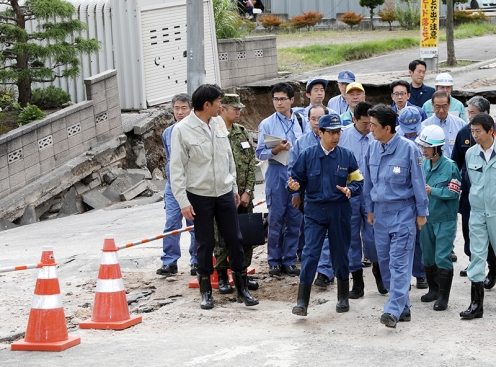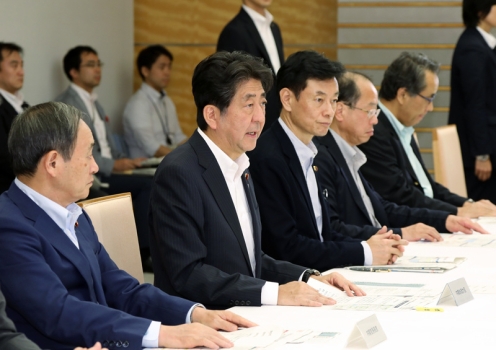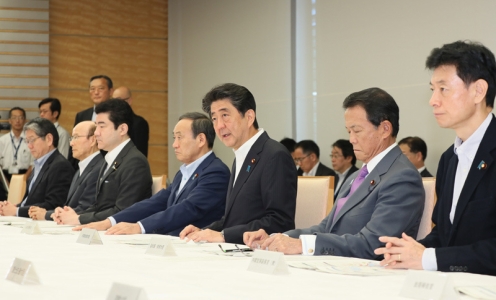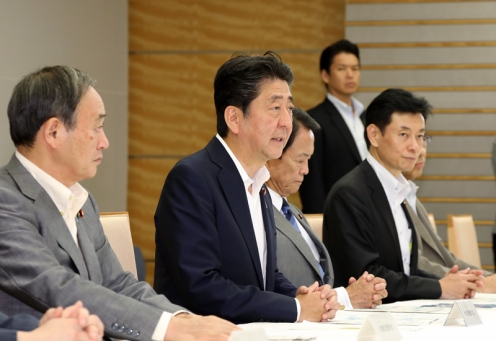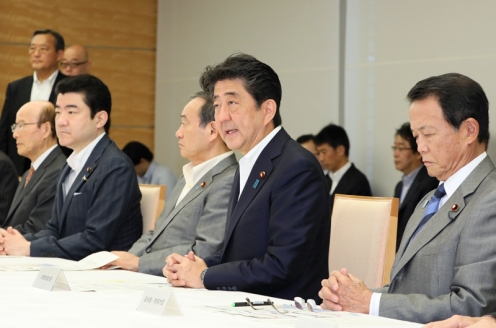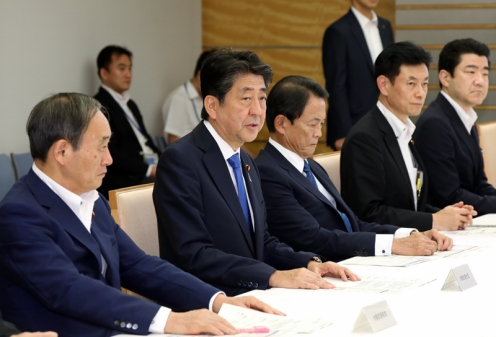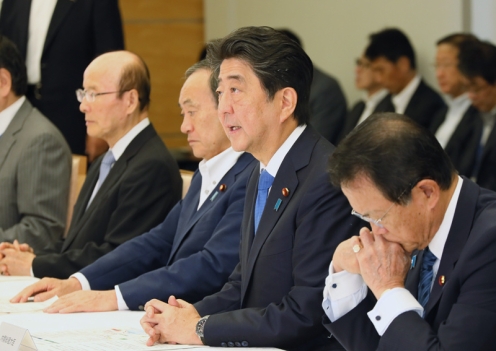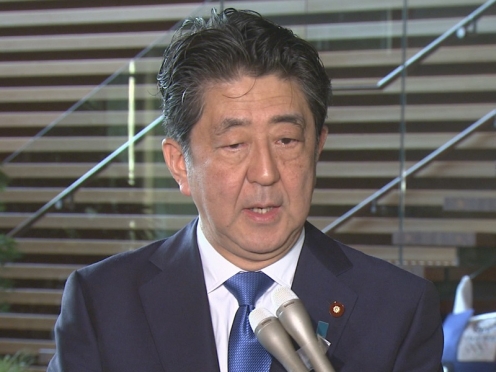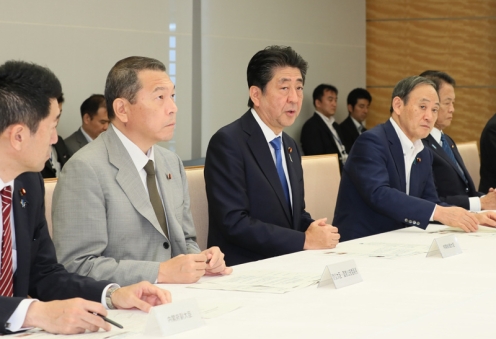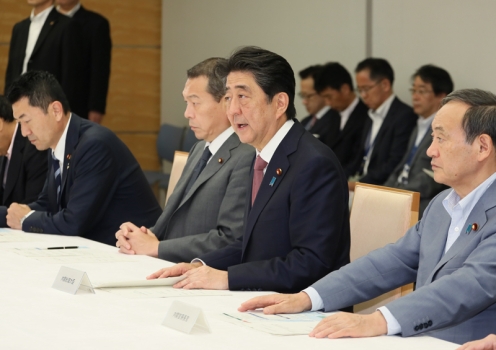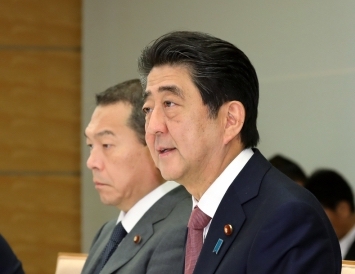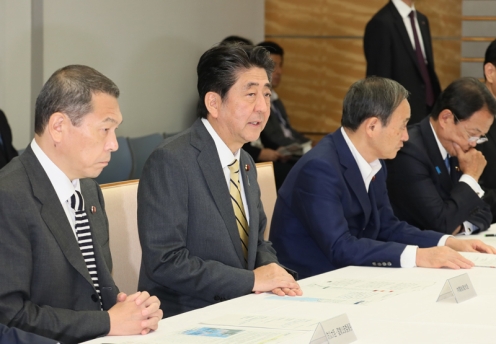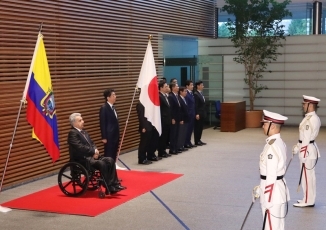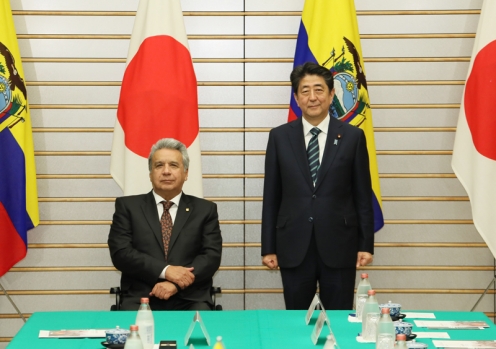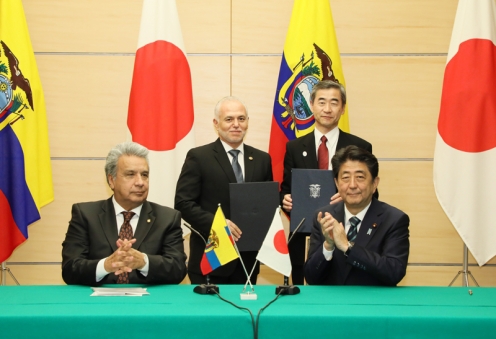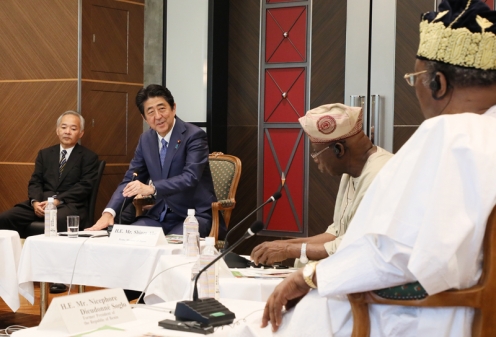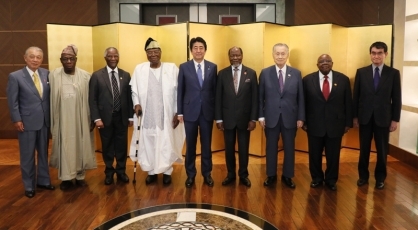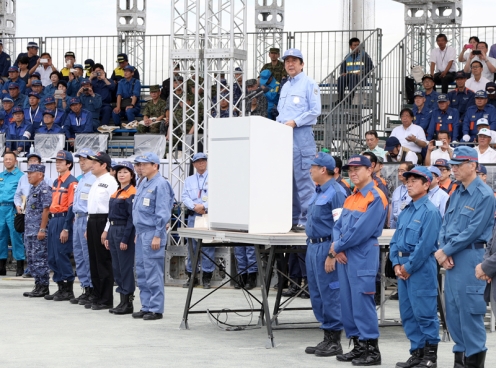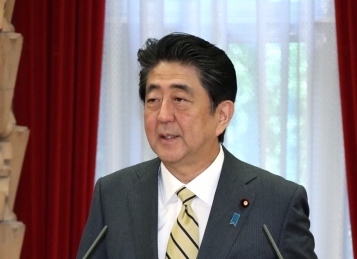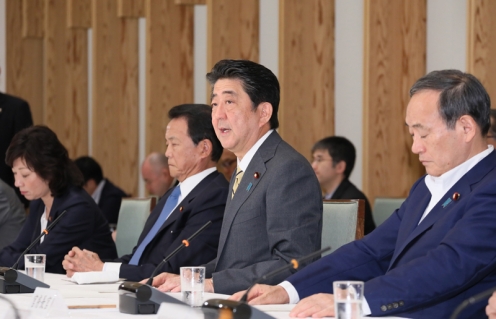Visit to Hokkaido to Inspect the State of the Damage Caused by the 2018 Hokkaido Eastern Iburi Earthquake
Cabinet Secretariat, Sunday, September 9, 2018
[Provisional Translation]
On September 9, 2018, Prime Minister Shinzo Abe visited Hokkaido to inspect the state of the damage caused by the 2018 Hokkaido Eastern Iburi Earthquake.
The Prime Minister first visited a site in Sapporo City that had been affected by liquefaction.
After that, he conducted an aerial inspection of sites affected by landslides, including Atsuma Town in Yufutsu District, from a Self-Defence Forces helicopter.
Subsequently, the Prime Minister visited a site in Atsuma Town that had been affected by a landslide, and conducted an inspection of the site. He also visited an elementary school that is being used as an evacuation center and listened to evacuees.
The Prime Minister then visited a community center in Abira Town that is being used as an evacuation center and listened to evacuees. Following that, the Prime Minister exchanged views with Ms. Harumi Takahashi, Governor of Hokkaido, Mr. Shoichiro Miyasaka, Mayor of Atsuma Town, Mr. Shuichiro Oikawa, Mayor of Abira Town, and Mr. Yoshiyuki Takenaka, Mayor of Mukawa Town, and received a written request.
Sixth Meeting of the Ministerial Council on the 2018 Hokkaido Eastern Iburi Earthquake
Cabinet Secretariat, Saturday, September 8, 2018
[Provisional Translation]
On September 8, 2018, Prime Minister Shinzo Abe held a meeting of the Ministerial Council on the 2018 Hokkaido Eastern Iburi Earthquake at the Prime Minister’s Office.
The Prime Minister said in his address,
“In the affected areas, units with approximately 41,000 personnel are exerting every effort even now to find and rescue the missing people as early as possible. Power supply has resumed across the whole of Hokkaido, except 7,000 homes, which are still experience power outage. Meanwhile, since it is expected that power supply remains tight, we have decided a series of electricity measures today in order to prevent the recurrence of large-scale power outages. I would like to ask the relevant ministries and agencies to implement the measures together.
Under the circumstance that more than 10,000 people are being forced to live at evacuation centers throughout Hokkaido, the Self-Defense Forces (SDF) are making every effort to carry out attentive operations to support their daily lives while being mindful of the affected people, including providing water supply assistance in 14 locations, food supply assistance in 13 locations, and bathing assistance in 4 locations.
With regard to push-mode food supports, 37,000 items of foods and drinks have arrived at distribution centers in Hokkaido, of which 22,000 items have been delivered to evacuation centers in nine municipalities in total, including Atsuma Town, Abira Town, and Mukawa Town. We will make continued efforts to ensure that the necessary foods reach the affected people.
With regard to housing, the Hokkaido Government has decided to provide 272 homes operated by the prefecture in the suburbs of the affected areas, including Tomakomai City, for the affected people. The Government will also coordinate with the affected municipalities to take swift measures to secure emergency housing, so that the affected people can take the first step towards rebuilding their lives at the earliest possible date.
Circumstances permitting, I will visit the affected areas tomorrow to see the extent of the damages with my own eyes, hear the voices of the affected people and local governments, so as to reflect them in our responses.
I would also like each of you to implement various measures in a swift and flexible manner, anticipating the needs on the ground based on real information through sending your staff to the affected areas.
In the areas affected by Typhoon No. 21*, such as Wakayama and Osaka Prefectures, while power restoration work has been under way day and night, over 40,000 homes are still without power due to the severe damages sustained, including fallen utility poles. We will increase the number of personnel engage in the work to 12,000 people to restore power as soon as possible and accelerate further the restoration work with the cooperation of power companies such as increasing equipment to repair utility poles, in addition to various emergency measures including distributing portable power generators.”
* Typhoon Jebi
Fifth Meeting of the Ministerial Council on the 2018 Hokkaido Eastern Iburi Earthquake
Cabinet Secretariat, Saturday, September 8, 2018
[Provisional Translation]
On September 8, 2018, Prime Minister Shinzo Abe held a meeting of the Ministerial Council on the 2018 Hokkaido Eastern Iburi Earthquake at the Prime Minister’s Office.
The Prime Minister said in his opening address,
“Two days have passed since the earthquake. The rescue and relief efforts for the missing people are a battle against time. Even now rescue units with approximately 40,000 personnel are tirelessly engaging in rescue and relief activities for the missing people, among other operations.
With regard to the power outage that affected 2.95 million homes across Hokkaido, work was carried out throughout the night to increase power supply. As a result, by this morning, the distribution of electricity has been resumed in all regions of Hokkaido and the number of homes experiencing power outage has been reduced to 20,000, which are locate in areas sustained damages to power distribution facilities and others.. We will exert every effort to restore power in these remaining areas. In addition, as power supply is still tight, I would like to ask the people of Hokkaido for their continued cooperation with conserving electricity as much as possible.
With the restoration of power, 80% of all gas stations in Hokkaido, or more than 1,400 gas stations, will reopen today. Convenience stores are also starting businesses in succession; today, the supply of bento (packed meals) will be increased, and three times the usual amount of cup noodles and water has already been shipped.
With the restoration of power, infrastructures have resumed service as well. Meanwhile, approximately 31,000 homes still do not have running water due to the damages to waterworks facilities and others. The relevant entities will continue to make an all-out effort to restore water supply at the earliest possible time.
At this moment, over 10,000 evacuees are facing uneasy and challenging times across Hokkaido. In order to protect the lives and the living environment of the affected people, the Government will continue to utilize push-mode supports to seamlessly supply to the affected people with daily essentials such as water and foods as well as fuels for the power generators of hospitals and others. The Government will provide financial support to this end. We will put together a contingency fund.
I would like to ask everyone to take prompt emergency response and recovery measures, in coordination with the affected municipalities and others, while fully paying heed to the voices and needs of the local people.
With another earthquake with a seismic intensity of 4 occurring last evening, the situation in the affected areas remains unpredictable. I ask the people of Hokkaido to continue to be on alert for earthquake activities and the weather.”
Fourth Meeting of the Ministerial Council on the 2018 Hokkaido Eastern Iburi Earthquake
Cabinet Secretariat, Friday, September 7, 2018
[Provisional Translation]
On September 7, 2018, Prime Minister Shinzo Abe held a meeting of the Ministerial Council on the 2018 Hokkaido Eastern Iburi Earthquake at the Prime Minister’s Office.
The Prime Minister said in his opening address,
“In the wake of the devastating damages caused by the recent earthquake, we have further strengthened our efforts in the affected areas and, at this stage, rescue units with a total of approximately 40,000 personnel, including 24,000 Self-Defense Forces (SDF) personnel, are exerting all efforts to search for missing people on a 24-hour basis.
With regard to the power supply, we have mobilized power stations that can be operated, including not only those of Hokkaido Electric Power Co., Inc. (HEPCO) but also other power generation businesses, and taken all possible measures, including the cooperation of non-utility power generation of private companies in Hokkaido and power interchange from Honshu (the main island). As a result, we expect that, by the end of tomorrow, maximum power supply capacity of around 3.6 million kW will be secured and power will be restored across the whole of Hokkaido, with the exception of some areas which sustained damages to their power distribution facilities due to the earthquake.
Meanwhile, until Tomatoh-Atsuma Power Station, the largest thermal power station in Hokkaido, resumes operations, we will continue to see tight power supply that barely meets demand. Based on past experience, it is very probable for the power demand to swing upwards on the next weekday, the beginning of next week. On the supply side, there is also risks that the supply will decrease if problems occur at old thermal power stations. Under such circumstances, to maintain power supply to everyone in Hokkaido, the Government and HEPCO will continue to strive to further top up power supply. At the same time, we must ask the people of Hokkaido to conserve electricity as much as possible.
In order to prevent the recurrence of power outages after supply is restored, I would like to ask the relevant ministries and agencies to work as one to immediately compile effective measures.
With the restoration of power, water supply is also being restored in all places, and transportation infrastructure has begun to steadily resume service. Today, in addition to Hokkaido Shinkansen, the Rapid Airport express train, connecting Sapporo and New Chitose Airport, and other train services have been resumed. At New Chitose Airport, following the resumption of some domestic flights today, a majority of domestic flights are expected to resume tomorrow. In addition, all international flights are expected to resume from tomorrow morning. We will continue to strive to restore infrastructure as quickly as possible.
There still remain many people affected by the disaster who are forced to lead hard lives at evacuation centers and elsewhere. The Government will work resolutely to provide supports, led by the push-mode support coordination meeting comprised of relevant ministries and agencies that was established today. To ensure that adequate amounts of water and food reach all the affected people, the supplies that will be necessary in future, will be transported to the SDF Iruma Air Base by the end of today, and delivered to the repositories designated by local governments, by making use of the transportation capacities of the SDF. Furthermore, the SDF and police departments will coordinate to ensure that the supplies in Hokkaido reach evacuation centers, supermarkets, and other facilities across the prefecture with the cooperation of the trucking industry and other relevant organizations. I would like to ask everyone to continue to exert every effort on emergency response and recovery measures in the affected areas, in coordination with the affected municipalities and others and following through with the front-line approach.
Significant rainfall is expected in the affected areas through tomorrow morning. I would like to ask the people of Hokkaido to continue to be on alert and be mindful of taking actions to save your lives.”
Third Meeting of the Ministerial Council on the 2018 Hokkaido Eastern Iburi Earthquake
Cabinet Secretariat, Friday, September 7, 2018
[Provisional Translation]
On September 7, 2018, Prime Minister Shinzo Abe held a meeting of the Ministerial Council on the 2018 Hokkaido Eastern Iburi Earthquake at the Prime Minister’s Office.
The Prime Minister said in his opening address,
“The recent earthquake has claimed the lives of 16 people to date. We have confirmed many people with serious and minor injuries along with the collapses of building and landslides. I pray for the repose of the souls of those who lost their lives and I extend my condolences to everyone who has been affected by the disaster.
Even now the safety of 26 people is unaccounted for in and around Atsuma Town. At this stage, rescue units with a total of 22,000 personnel are tirelessly implementing rescue and relief operations throughout the night. We will continue to flexibly strengthen our efforts further and make every endeavor to save people’s lives.
With regard to the power outage, as of now power supply has been restored to 1.4 million homes, or roughly half of all homes in Hokkaido, thanks to the steadfast restoration work that has been carried out all through the night, the cooperation through non-utility power generation by private companies in Hokkaido, and power interchange from Honshu (the main island). With the restoration of power, water supply has been also resumed to 4,000 homes. In addition, we expect otherservices to steadily reopen such as transportation infrastructure including New Chitose Airport and gas stations. Our thoughts are with those who are affected and forced to spend the night in the dark feeling uneasy. Today, I would like to ask everyone to continue to exert every effort, including resuming the operation of thermal power stations, in order to ensure that power can be supplied to as many households as possible at the earliest possible point. Please make sure that power remains distributed to critical facilities such as hospitals. I would like to ask for the continued cooperation to conserve electricity in areas where the power supply has been restored so that power can be supplied to as many people as possible.
Amidst the ongoing power outage and suspension of water supply, many people are spending their time anxiously at evacuation centers and elsewhere. I ask everyone to coordinate closely with the affected municipalities and relevant entities to implement push-mode support to provide supplies that are needed, including food and other daily essentials. Please proactively implement measures in advance, including securing the necessary personnel to engage in disaster response and supporting the early recovery of lifelines.
Rainfall is expected in the affected areas from this afternoon through tomorrow morning. Buildings could collapse, and landslide disasters could occur. I would like to ask the people of Hokkaido to continue to be on alert for earthquake activities and the weather.”
Second Meeting of the Ministerial Council on the 2018 Hokkaido Eastern Iburi Earthquake
Cabinet Secretariat, Thursday, September 6, 2018
[Provisional Translation]
On September 6, 2018, Prime Minister Shinzo Abe held a meeting of the Ministerial Council on the 2018 Hokkaido Eastern Iburi Earthquake at the Prime Minister’s Office.
The Prime Minister said in his opening address,
“The 2018 Hokkaido Eastern Iburi Earthquake, which had a maximum seismic intensity of 7, has claimed the lives of nine people to date, with the safety of many people still unaccounted for in and around Atsuma Town. Many buildings have also collapsed and landslides have been confirmed. I pray for the repose of the souls of those who lost their lives and I extend my sincere condolences to everyone who has been affected by the disaster.
The Government is making every endeavor to implement rescue and relief operations, with units from the Self-Defense Forces (SDF), police departments, fire departments, and the Japan Coast Guard, including personnel from outside Hokkaido, providing support. 21,000 personnel, 51 helicopters and 12 ships have been mobilized. We will continue to further strengthen and enhance the scale of rescue units. With a view to preventing secondary disasters, the Government has dispatched the landslide expert team, TEC-FORCE, to Hokkaido. We will continue to work closely with the affected municipalities, exerting full efforts on emergency disaster response measures.
With regard to the power outage across the whole of Hokkaido, as a result of hydroelectric and thermal power stations being restarted, power transmission has been resumed to 300,000 homes in part of Sapporo City. We are aiming to restore the power supply to 1 million households, or approximately one-third of all homes in Hokkaido by tomorrow morning, by working through the night today. In order to ensure that power can be supplied to as many people as possible, I would like to ask those who are in areas where the power supply has been restored to make efforts to conserve electricity.
However, given that the full restoration of the power supply is anticipated to take some time, we have made arrangements for more than 300 tank trucks to provide fuel supplies for emergency power supply to important facilities, including hospitals, water and sewerage works and communications base stations. In addition, we have secured 150 power-supply vehicles from power companies around the country. It is expected that 35 of these vehicles will arrive in Hokkaido tonight and exert every effort to provide power supply to these important facilities.
I would like all ministers to continue your efforts to grasp the state of damage and exert every effort to engage in rescue and relief activities, based on a policy of putting people’s lives first. I also ask for all measures to be taken to secure food and other daily essentials and restore lifeline services.
In the areas which have experienced heavy tremors, there is still a danger of further building collapses and landslides, so I ask the people in affected areas to remain aware of further seismic activity and weather conditions, and take actions to protect their lives accordingly.”
Ministerial Council on the Earthquake with an Epicenter in Central and Eastern Iburi Region in Hokkaido Prefecture
Cabinet Secretariat, Thursday, September 6, 2018
[Provisional Translation]
On September 6, 2018, Prime Minister Shinzo Abe held a meeting of the Ministerial Council on the Earthquake with an Epicenter in Central and Eastern Iburi Region in Hokkaido Prefecture at the Prime Minister’s Office.
The Prime Minister said in his opening address,
“We have confirmed many cases of injuries and damage caused by the recent earthquake of a maximum seismic intensity of 6 Upper, with an epicenter in Central and Eastern Iburi Region, including the cases of collapsed buildings and landslides in Atsuma Town. The police and fire departments are also receiving several reports of missing persons, collapsed buildings and landslides due to the earthquake.
Widespread power outages have occurred throughout Hokkaido, including Sapporo City.
The Government is advancing efforts to grasp the state of the damage and is working as one to address the situation based on a policy of putting people’s lives first.
On the ground, 4,000 self-defense force (SDF) personnel have already begun rescue operations. We plan to increase this to 25,000 personnel soon. SDF units, police departments, fire departments, and the Japan Coast Guard will exert every effort for rescue and relief.
There is no time to lose. I would like each of the Ministers to swiftly grasp the state of the damage and exert an all-out effort for the rescue and relief of those affected by the disaster, the evacuation of residents, and the restoration of lifelines, while working closely together with the affected municipalities and other related parties.”
Press Conference on the Earthquake with an Epicenter in Central and Eastern Iburi Region in Hokkaido Prefecture
Cabinet Secretariat, Thursday, September 6, 2018
[Provisional Translation]
On September 6, 2018, Prime Minister Shinzo Abe held a press conference at the Prime Minister’s Office.
With regard to the earthquake with an epicenter in central and eastern Iburi Region in Hokkaido Prefecture, the Prime Minister said,
“I have received reports on the injuries and damage caused by this earthquake, including people who have suffered cardiopulmonary arrests, landslides, collapsed buildings and widespread power outages. Putting the people’s lives first, the Government will work as one to carry out emergency disaster response measures. We will take thorough actions from the perspective of crisis management.”
Prime Minister's Instructions on the Earthquake under the Iburi Region, Hokkaido (3:10)
Cabinet Secretariat, Thursday, September 6, 2018
Immediately after the quake, PM Abe instructed to:
1) identify the damages as soon as possible,
2) coordinate closely with local municipalities, work as the government as a whole make utmost effort in disaster response including rescuing affected people, and
3) ensure no damages would extend.
The 2018 Hokkaido Eastern Iburi Earthquake -Portal-
JMA, Friday, September 7, 2018
Please check source website for information on seismic intensity at each site and weather information for disaster-affected areas.
23rd Meeting of the Emergency Response Headquarters for the Heavy Rain in July 2018
Cabinet Secretariat, Thursday, September 6, 2018
The Prime Minister said in his opening address,
“First, regarding the Earthquake with an Epicenter in Central and Eastern Iburi Region in Hokkaido Prefecture,* the Government is working as one to carry out rescue and relief operations, and other efforts, with all its strength. I extend my sincere sympathies to everyone who has been affected by the disaster.
In addition, 12 people have lost their lives due to the heavy winds and rains caused by Typhoon No. 21.** I would like to express my heartfelt condolences. I furthermore extend my sympathies to the many people who have been injured or otherwise been affected by the typhoon, including suffering damage to their homes or power outages.
With regard to Kansai International Airport, which has become inundated due to the storm surge and where an access bridge was damaged when a tanker collided with it, we are working around the clock on repairs, including draining water and switching out damaged radio equipment.
Led by the task force set up in the Prime Minister’s Office, we are advancing rigorous considerations on means to restore the functions of the airport as soon as possible. We will first restore domestic flights tomorrow, and proceed to restore international flights as soon as the necessary preparations are in place. While there are many challenges, such as damage to the fueling equipment, we will determine the specific actions to take at each stage of the restoration process, including the emergency stage, temporary reopening and full reopening. We will present an overview of these actions tomorrow.
Regarding the situation on the ground in the areas in western Japan, which were affected by the heavy rains that occurred two months ago, the Government as a whole is carrying out initiatives to rebuild the lives of those affected and restore their ‘nariwai’ (occupations and livelihoods that sustain people’s daily lives), based on the support package compiled in August. Specifically, we have completed the work to remove debris and landslide sediment from the 10 districts most heavily affected, such as Kawasumi District in Kumano Town, Hiroshima Prefecture, as well as the emergency work to dredge and remove trees and other debris from rivers, such as the Oda River in Okayama Prefecture and the Hijikawa River in Ehime Prefecture. With respect to the remaining affected districts, we are accelerating efforts so as to complete the work within September. Furthermore, we will make considerate and thorough efforts to restore the ‘nariwai’ of micro, small and medium-sized enterprises, and agricultural, forestry, and fishery workers affected by the disaster. We will increase the number of eligible travel destinations, such as by including other affected prefectures to the scope of the ’Fukko Shuyu Wari’ (the multi-destination discount program to support reconstruction), which is already being implemented as a measure to counter any negative effects to the tourism industry caused by harmful rumors. Furthermore, regarding efforts to secure temporary housing, approximately 4,500 units of public and provisional temporary housing have been designated to accept residents, and approximately 670 ‘constructed’ emergency temporary houses are expected to be completed this month in the prefectures of Hiroshima, Okayama and Ehime. We will continue to provide seamless support, including the provision of housing, financial assistance and mental care.
In order to advance repair and reconstruction work properly, the Minister of Finance has made preparations for the second tranche of contingency fund disbursements amounting to 61.6 billion yen for the matters currently requiring financial assistance. This will be approved by a Cabinet decision tomorrow.
Repair and reconstruction work in the affected regions must be urgently addressed. I ask everyone to continue to exert every effort for rebuilding and restoring the affected areas, so that the disaster victims can take firm steps towards rebuilding their lives and live with peace of mind, as soon as possible.”
*The 2018 Hokkaido Eastern Iburi Earthquake
**Typhoon Jebi
Transportation and tourist information after Typhoon No.21
MLIT, Friday, September 7, 2018
Please access source page for information about Transportation and tourist information after Typhoon No.21.
22nd Meeting of the Emergency Response Headquarters for the Heavy Rain in July 2018
Cabinet Secretariat, Tuesday, September 4, 2018
[Provisional Translation]
On September 4, 2018, Prime Minister Shinzo Abe attended the 22nd meeting of the Emergency Response Headquarters for the Heavy Rain in July 2018 at the Prime Minister’s Office.
The Prime Minister said in his opening address,
“Typhoon No. 21* has made landfall at about 12:00 p.m. today with its extreme strength, and is currently moving northward along the coast of the Sea of Japan at high speed.
Several regions, particularly Kinki, have been hit by ferocious winds and rain, and tide levels in the coastal regions are reaching a historical high.
The typhoon is expected to continue moving northward along the coastal line of the Japanese archipelago, facing the Sea of Japan. Please maintain a high level of vigilance across a wide area from western to northern Japan for heavy rain and windstorms.
As of now, many people have been injured and a large number of houses have suffered damage. Approximately 177,000 households across 16 prefectures are experiencing power outages. At Kansai International Airport, a large part of the runways have been flooded. There has also been an accident in which a tanker has collided with the airport’s access bridge. I would like to extend my sympathies to all those who have been affected.
Relevant agencies and other entities, including the police, fire department, coast guard, and power companies, are currently taking steps to accelerate the pace of their designated rescue and relief operations and recovery work as fast as possible.
I ask each of you to swiftly identify the status of the damage and continue to exert your utmost efforts to prevent the spread of damage and injury as much as possible, such as through rescue and relief operations, restoration of infrastructure, and urging residents to evacuate, in cooperation with local governments and related organizations.
Even after the typhoon passes, we might experience heavy rains locally. I ask the people to take action to protect your lives, such as by evacuating early without any hesitation before dark.”
*Typhoon Jebi
21st Meeting of the Emergency Response Headquarters for the Heavy Rain in July 2018
Cabinet Secretariat, Tuesday, September 4, 2018
[Provisional Translation]
On September 4, 2018, Prime Minister Shinzo Abe attended the 21st meeting of the Emergency Response Headquarters for the Heavy Rain in July 2018 at the Prime Minister’s Office.
The Prime Minister said in his opening address,
“Thereafter, Typhoon No. 21* is expected to make landfall very soon from the Shikoku region to the Kii Peninsula, while maintaining its extreme strength. Heavy rains are already spreading out over a wide area, and there are concerns that the heavy wind and rain will continue, causing flooding of rivers and landslides.
In addition, tide levels are rising in the Seto Inland Sea and the Hokuriku region. Particularly along the coast of Osaka Bay, there are concerns of record-breaking high tides that are comparable with the highest tide levels ever recorded in history. I would like to ask you to thoroughly ensure a high level of vigilance.
The Government will enhance its vigilance and put necessary measures in place. The typhoon is already beginning to have an impact on the lives of the citizens, such as the suspension of transport services and power outages. I ask each of you to continue exerting your utmost efforts to prevent the occurrence of damage and injury as much as possible, such as by urging residents to take the appropriate evacuation actions, while working in cooperation with the local governments and related organizations, and without worrying that it might ultimately be unnecessary.
This typhoon is speeding up rapidly near Japan and moving northward. Weather conditions are deteriorating drastically. I ask the people not to let down your guard even if the situation is safe right now. Please take action to protect your lives by making prior preparations, such as checking their emergency supplies and food stock, and confirming their evacuation centers and safe evacuation routes, as well as being mindful of evacuating early.”
*Typhoon Jebi
20th Meeting of the Emergency Response Headquarters for the Heavy Rain in July 2018
Cabinet Secretariat, Monday, September 3, 2018
[Provisional Translation]
On September 3, 2018, Prime Minister Shinzo Abe attended the 20th meeting of the Emergency Response Headquarters for the Heavy Rain in July 2018 at the Prime Minister’s Office.
The Prime Minister said in his opening address,
“Typhoon No. 21* is expected to make landfall from the Shikoku region to the Kii Peninsula during daytime tomorrow, September 4. It is the first time in 25 years that a typhoon will make landfall while still maintaining its extreme strength. There are concerns that it may cause heavy wind and rain, flooding of rivers, landslides, and high water levels over a wide area. Please remain on high alert.
In response to the arrival of the successive typhoons, in the areas that were affected by the heavy rain in western Japan, we have implemented various emergency measures such as installing drainage pump vehicles to respond to potential flooding, conducting monitoring around-the-clock, in addition to dredging rivers. To prevent secondary disasters, please take advance measures, including early initiation of evacuation measures, without worrying that it might ultimately be unnecessary.
A short while ago, Minister of State for Disaster Management Okonogi convened an Inter-Agency Disaster Alert Meeting, and the Government is now on heightened alert. I ask that each of you implement measures, working in unity as the Government, to prevent damages wherever possible, including disseminating information in a manner that is easy to understand and lead to evacuations in a timely manner as well as sending warnings or giving advice to local governments and related organizations.
This typhoon is expected to speed up rapidly near Japan. As the typhoon approaches, rain and wind suddenly intensify. Therefore, I ask the people to take action to protect your lives without letting your guard down by making prior preparations, such as checking their emergency supplies and food stock and confirming their evacuation centers and safe evacuation routes, as well as being mindful of evacuating early.”
* Typhoon Jebi
Japan-Ecuador Summit Meeting
Foreign Affairs, Wednesday, September 5, 2018
On September 5, commencing at around 6 p.m. for approximately 40 minutes, Mr. Shinzo Abe, Prime Minister of Japan, held a summit meeting with H.E. Mr. Lenín Boltaire Moreno Garcés, President of the Republic of Ecuador, who was making an official working visit to Japan. The overview of the meeting is as follows. The meeting was attended by Mr. Yasutoshi Nishimura, Deputy Chief Cabinet Secretary, and Mr. Kotaro Nogami, Deputy Chief Cabinet Secretary, among other government officials.
After the summit meeting, a signing ceremony and exchange of notes ceremony were held in the presence of the two leaders. Following that the two leaders held a joint press announcement, and a Japan-Ecuador Joint Statement was issued. Subsequently, a banquet hosted by Prime Minister Abe and his wife took place in a relaxed atmosphere, and the conversation touched on a broad range of topics relating to the bilateral relationship.
1. Japan-Ecuador Summit Meeting
(1) Opening remarks
(i) Prime Minister Abe expressed his happiness at being able to welcome President Moreno to Japan this year, which is the 100th anniversary of the establishment of Japan-Ecuador diplomatic relations, and expressed his respect for the political and economic reforms that President Moreno is actively pursuing. In addition, Prime Minister Abe explained that, at the occasion of this President’s visit to Japan, he hopes to develop the relationship between the two countries in a large number of areas, including political and economic relations and people-to-people exchanges, toward the next century.
(ii) In response, President Moreno expressed the view that the 100th anniversary of the establishment of diplomatic relations is a beginning for both countries, explained that he is happy to visit Japan, which is a model for many countries, and expressed gratitude for the welcome he received.
(2) Bilateral relations
(i) Prime Minister Abe noted that high-level exchanges are continuing this year, beginning with Cabinet ministers and Diet members, and expressed his intention to further advance cooperation. In addition, with regard to the development cooperation field, Prime Minister Abe welcomed that they were able to sign the exchange of notes on the provision of 70 million USD of loans for electricity distribution, the first such financing in approximately 20 years, along with explaining that Japan will continue to cooperate in the fields of disaster-prevention and human resources training that are needed by the Ecuadorian side.
(ii) Moreover, with regard to the two countries’ economic relationship, the two leaders welcomed that they agreed in principle on the tax convention aimed at promoting investment and economic exchanges, and amid the striking advances being made in the cooperative relationship in the fields of terrestrial digital broadcasting and information and communications technology (ICT), including disaster-prevention and broadcasting access for people with visual and hearing disabilities, they also welcomed the signing of a memorandum for further strengthening the relationship.
(iii) In the field of people-to-people exchanges between citizens, Prime Minister Abe noted that multilayered exchanges were proceeding between regions and in areas such as culture and sports, and conveyed Japan’s decision to relax multiple-entry visas for Ecuadorian nationals in order to further invigorate people-to-people exchanges between the two countries.
(iv) President Moreno began by expressing his condolences over the damages caused by recent typhoon (Typhoon No. 21), and then mentioned bilateral exchanges such as Dr. Hideyo Noguchi’s research in Ecuador, and noted that Ecuador and Japan share views on a large number of challenges such as disarmament, the environment and human rights. President Moreno also expressed gratitude for the cooperation extended by Japan thus far, and expressed expectation over ongoing cooperation from Japan in the field of the economy.
(3) Cooperation in the international arena and regional affairs
Prime Minister Abe conveyed his congratulations on the appointment of H.E. Mrs. Maria Fernanda Espinosa Garcés, former Minister for Foreign Affairs and Human Mobility of Ecuador, as President of the United Nations General Assembly (UNGA) for the 73rd session, and the two leaders shared the view that they will deepen the cooperative relationship in the UN. They also exchanged views on regional affairs, including North Korea. With regard to North Korea, they confirmed the need for the complete, verifiable and irreversible dismantlement (CVID) of all weapons of mass destruction and ballistic missiles of all ranges by North Korea. In addition, they shared the view that they will continue to coordinate toward the full implementation of UN Security Council resolutions. Prime Minister Abe sought understanding and cooperation on the early resolution of the abductions issue, and obtained the support of President Moreno.
2. Signing ceremony and exchange of notes ceremony
After the summit meeting, the following related signing ceremony and exchange of notes ceremony were held in the presence of the two leaders.
(1) Signing of a memorandum of cooperation in the terrestrial digital broadcasting and information and communications technology (ICT) fields (Japanese side: Ms. Seiko Noda, Minister for Internal Affairs and Communications; Ecuadorian side: H.E. Mr. José Samuel Valencia Amores, Minister for Foreign Affairs and Human Mobility).
(2) Exchange of notes on the “Project for Supporting the Advancement of Energy Matrix Transition” loan aid (Japanese side: Mr. Hitoshi Noda, Ambassador Extraordinary and Plenipotentiary of Japan to Ecuador; Ecuadorian side: H.E. Mr. Jaime Barberis, Ambassador Extraordinary and Plenipotentiary of Ecuador to Japan).
Japan-Ecuador Summit Meeting and Other Events
Cabinet Secretariat, Wednesday, September 5, 2018
[Provisional Translation]
On September 5, 2018, Prime Minister Shinzo Abe held a summit meeting and other events with H.E. Mr. Lenín Boltaire Moreno Garcés, President of the Republic of Ecuador, at the Prime Minister’s Office.
The two leaders attended a salute and guard of honor ceremony and then held a summit meeting. Afterwards, the leaders held a signing ceremony, an exchange of documents ceremony, and a joint press announcement; the Japan-Ecuador Joint Statement was released.
Lastly, the Prime Minister hosted a banquet at the Prime Minister’s Official Residence and said in his address,
“I would like to offer my heartfelt welcome to President Moreno and his wife on their visit to Japan. I am extremely pleased to have you both in Tokyo on the occasion of the 100th anniversary of Japan-Ecuador diplomatic relations.
While Japan and Ecuador are separated by great geographical distance, our two countries are in fact connected through a variety of bonds. One example is Dr. Hideyo Noguchi. In the year that our diplomatic relations were first established, 100 years ago, Dr. Noguchi began researching yellow fever in Ecuador. The story of his distinguished service, which saved many lives, is still told today, and I was told that there are statues erected in honor of Dr. Noguchi across Ecuador.
The famous Galapagos Islands are also in Ecuador. By the way, my own cell phone is what we in Japan call a ‘Galapagos phone.’* With both beautiful nature and a treasure trove of rare animals, the Galapagos Islands were the first location designated as a UNESCO Natural World Heritage Site, and are today visited by many Japanese tourists.
Ecuador is also the world’s largest exporter of bananas, and accounts for the second largest share of banana exports to Japan. The Tanabe Farm bananas, grown by Mr. Tanabe who has joined us today from Ecuador, are premium bananas that sell for 100 yen each, and are highly popular at premium supermarkets such as Seijo Ishii and at convenience stores.
This evening, we have invited leading figures from across the country who are supporting the friendship between our two countries in a variety of fields, such as politics, the economy, and culture. It is thanks to all your efforts that Japan and Ecuador share such excellent relations today. I would like to take this opportunity to thank all of you and ask for your continued support for the further development of Japan-Ecuador relations.
I now wish to offer a toast to the good health of President Moreno and his wife, and all the distinguished guests here tonight, as well as to the further strengthening of the bonds between our two countries across the Pacific for another 100 years of friendship. Everyone, please raise your glasses to the continued development of the Japan-Ecuador relationship. Cheers!”
*A flip-phone
Exchange of Notes Concerning Loan Aid to Ecuador
Foreign Affairs, Wednesday, September 5, 2018
1. On September 5, following the Japan-Ecuador summit meeting in Tokyo, Mr. Hitoshi Noda, Ambassador Extraordinary and Plenipotentiary of Japan to the Republic of Ecuador, and H.E. Mr. Jaime Barberis, Ambassador Extraordinary and Plenipotentiary of the Republic of Ecuador to Japan, exchanged notes concerning the provision of a loan aid up to 70 million U.S. dollars in total for the Project for Supporting the Advancement of Energy Matrix Transition, in the presence of Mr. Shinzo Abe, Prime Minister of Japan, and H.E. Mr. Lenín Boltaire Moreno Garcés, President of the Republic of Ecuador.
2. Overview of the Project
Ecuador has been developing hydropower systems using its abundant hydropower resources as one of the pillars for transition of the energy matrix. Meanwhile, many households and primary industries in remote areas and elsewhere are still unconnected to power grids.
In light of these circumstances, this project will support for expanding and strengthening the national power grid and the establishment of legal and institutional frameworks promoting energy saving in Ecuador, through the Co-financing for Renewable Energy and Energy Efficiency (CORE) program with the Inter-American Development Bank (IDB). It is expected that this will enable hydropower-generated electricity to provide a stable power supply to an additional 16,680 households and the consumption sector, including local industries related to key exports, and contribute to promoting energy saving.
3. Loan Terms
(1) Rate of interest : 6-month U.S. dollar LIBOR+110bp
(Note) 0.1% interest rate floor
(2) Repayment period : 25 years (after a grace period of 7 years)
(3) Procurement terms : Untied
(Note) This loan will be provided denominated in U.S. dollars. Dollar-denominated loans were established in April 2016 based on the follow-up measures of the “Partnership for Quality Infrastructure” announced by the Government of Japan in November 2015.
(Reference) Japan-Ecuador Relations (Basic Data)
The Republic of Ecuador is a country that has a land area of approximately 256,400 square kilometers (Japanese islands of Honshu and Kyushu combined) and a population of 16.39 million people (World Bank, 2016). It has a gross national income (GNI) per capita of approximately 5,800 U.S. dollars (World Bank, 2016).
Core Group Meeting of the Eminent Persons Group on Peace and Stability in Africa
Cabinet Secretariat, Friday, August 31, 2018
[Provisional Translation]
On August 31, 2018, Prime Minister Shinzo Abe attended the Core Group Meeting of the Eminent Persons Group on Peace and Stability in Africa held in Tokyo.
The Prime Minister said in his opening address,
“Your Excellencies, former President Chissano of Mozambique, former President Soglo of Benin, former President Mkapa of Tanzania, former President Obasanjo of Nigeria, and former President Mbeki of South Africa, I would like to extend my most heartfelt appreciation to you for coming all the way to Japan to attend the Core Group Meeting of the Eminent Persons Group on Peace and Stability in Africa.
It gives me great pleasure to see this Core Group Meeting take place today with the attendance of former Prime Minister Mori, who was the first Japanese Prime Minister to visit Sub-Saharan Africa, and Chairman Sasakawa of the Nippon Foundation, who is co-organizing this meeting.
Japan will host the Seventh Tokyo International Conference on African Development (TICAD 7) in Yokohama in August of next year. TICAD is a unique forum which brings together African leaders and various United Nations agencies, conducts discussions open to experts and non-governmental organizations (NGOs), and pools global wisdom on the future of Africa, and we expect to achieve meaningful outcomes at TICAD 7.
I have visited Africa twice as Prime Minister. Development and stability in Africa are directly linked to the peace and prosperity of the world, and Japan has made active efforts to further deepen our partnership with African countries under the policy of ‘Proactive Contribution to Peace’ based on the principles of human security and international cooperation.
I firmly believe that efforts built upon the voices of the people of Africa are the short cut to achieve peace and prosperity by strongly promoting development in Africa.
At today’s Core Group Meeting, we hope to hear the candid views of the eminent persons who have overcome numerous difficulties and brought peace and prosperity to the African continent in order to further advance the preparatory process for the success of TICAD 7.
I sincerely look forward to your lively exchanges of views and meaningful outcomes at today’s meeting. Thank you very much.”
Core Group Meeting of the Eminent Persons Group on Peace and Stability in Africa
Foreign Affairs, Saturday, September 1, 2018
1. The Ministry of Foreign Affairs and the Nippon Foundation co-hosted the Core Group Meeting of the Eminent Persons Group on Peace and Stability in Africa on 31st August and 1st Sepetember. Five former Heads of State were invited to the Meeting with the aim of suggesting proposals in the field of peace, security and stability in Africa.
2. In the opening of the Meeting presided over by H.E.Mr. Yoshiro Mori, Former Prime Minister of Japan, H.E. Mr. Shinzo ABE, Prime Minister of Japan, H.E. Mr. Joaquim Alberto CHISSANO, Former President of Mozambique, H.E. Mr. Taro KONO, Minister for Foreign Affairs of Japan and Mr. Yohei Sasakawa, Chairman of the Nippon Foundation, made statements. Among them, Prime Minister Abe mentioned that, listening to the frank views from each Eminent Person on the challenges and measures toward the realization of the peace and stability in Africa through the Meeting, he would like to make use of the discussion in preparing for TICAD 7. In addition, Foreign Minister Kono stated that, in conflicting states and fragile states, institution building and human resource development form the foundation of the peace and stability of those countries and Japan will support the nation-building of African countries including through its assistance in the above-mentioned fields.
3. After that, members from both Japan and Africa conducted an active discussion on several topics including challenges which should be tackled by Africa itself in order to ensure peace, security and stability in Africa. During the discussion, some members emphasized the importance to make efforts to secure national unity and promote institution building and expressed their great expectation to the Japanese efforts in such areas through TICAD process.
(Reference)
Members of Core Group Meeting of the Eminent Persons Group on Peace and Stability in Africa
Japan : H.E.Mr. Yoshiro Mori, Former Prime Minister of Japan (Co-Chair)
Mr. Yohei Sasakawa, Chairman of the Nippon Foundation
Africa : H.E. Mr. Joaquim Alberto Chissano, Former President of the Republic of Mozambique (Co-Chair)
H.E. Mr. Nicephore Dieudonné Soglo, Former President of the Republic of Benin
H.E. Mr. Benjamin William Mkapa, Former President of the United Republic of Tanzania
H.E. Chief. Olusegun Obasanjo, Former President of the Federal Republic of Nigeria
H.E. Mr. Thabo Mvuyelwa Mbeki, Former President of the Republic of South Africa
FY2018 Comprehensive Disaster Management Drills
Cabinet Secretariat, Saturday, September 1, 2018
[Provisional Translation]
On September 1, 2018 (Disaster Preparedness Day), Prime Minister Shinzo Abe took part in the FY2018 Comprehensive Disaster Management Drills together with all Cabinet members.
This year, the drills were conducted based on a scenario in which a Nankai Trough Earthquake occurred at around 7:10 a.m., with a magnitude of 9.1, a maximum seismic intensity of 7, and its epicenter in the coast south of Wakayama Prefecture.
As part of the drills, the Prime Minister walked to the assembling point at the Prime Minister’s Office and held the first meeting of the Extreme Disaster Management Headquarters and an emergency Cabinet meeting. Afterwards, the Prime Minister held a press conference to explain the overview of the earthquake and the status of the Government’s response, and to give a message to the people.
Then, the Prime Minister visited the venue of the joint disaster management drills by helicopter, which was held by the nine municipalities in Kawasaki City, Kanagawa Prefecture as a part of the government inspection team. At the venue, the Prime Minister observed a marine evacuation drill and an oil terminal fire extinguishing drill. The Prime Minister also took part in a drill exercise participated by residents. Subsequently, the Prime Minister observed a rescue and assistance drill.
At the closing ceremony of the drills, the Prime Minister said in his address,
“It is of great significance that disaster management drills of this scale were held today, on Disaster Preparedness Day, with the participation of approximately 140 organizations and approximately 8,000 people, including the people of Kawasaki City, the Self-Defense Forces, the police departments, the fire departments and the Disaster Medical Assistance Team (DMAT) of the nine participating municipalities as well as members of the private sector, including designated public institutions.
The natural conditions of Japan make all parts of the country prone to disasters, such as earthquakes, typhoons, heavy rains, and volcanic eruptions.
This year as well, torrential rains resulting from the seasonal rain front hit Japan, including the heavy rain in western Japan in July, and multiple typhoons have caused significant damages in various regions. I would like to once again extend my condolences for those who lost their lives and my deepest sympathies to all the affected people.
The Government will continue to exert every effort for the recovery and reconstruction of the affected areas to ensure that the affected people can take the first steps towards rebuilding their lives with hope and return to their daily lives with peace of mind.
In order to overcome the impacts of disasters, it is important that, as part of their daily lives, each and every person is fully prepared for times of emergency.
Today’s drills were participated by approximately 3,500 members of voluntary disaster prevention organizations and fire companies, which form the core of self-help and mutual support initiatives. The drills also saw the enthusiastic participation of approximately 600 elementary, junior high school, and specialized training college students who represent the future of Japan. This is very reassuring.
I hope that practical drills like these, which were conducted today, will help ensure disaster preparedness by developing strong connections between people in the community and the organizations involved in disaster management and deepening understanding about the risks in the areas where you live and the specific actions that should be taken during times of disaster.
The Government will continue to take all possible measures related to disaster management to protect the lives and property of the Japanese people in preparation for a range of disasters, including the Tokyo Inland Earthquake and Nankai Trough Earthquake which are feared to occur.
In closing, I would like to express my sincere appreciation to everyone for their enthusiastic participation in today’s drills. Thank you very much for your cooperation today.”
Party Hosted by the Prime Minister Accompanying the Meeting of the Ministry of Defense and Self-Defense Force Senior Personnel
Cabinet Secretariat, Monday, September 3, 2018
[Provisional Translation]
On September 3, 2018, Prime Minister Shinzo Abe hosted a party accompanying the Meeting of the Ministry of Defense and Self-Defense Force (SDF) Senior Personnel, at the Prime Minister’s Official Residence.
The Prime Minister said in his address,
“I am pleased to have this opportunity to have a talk with all of you who represent the 250,000 SDF personnel today. I would like to once again express my respect to the members of the SDF personnel who are diligently fulfilling their duties under severe conditions, 24 hours a day, 365 days a year, even at this very moment. I would also like to take this opportunity to express my sincere gratitude to all of their family members.
I have one more good news today. At the Asian Games which were held in Jakarta, athletes from the SDF won three gold medals, three silver medals, and two bronze medals. I have high expectations that they will equally do well at the Tokyo Olympic Games in 2020.
Anyway, over the last year, I had opportunities to visit various sites that the SDF operated.
In Maizuru, I observed the Aegis-equipped destroyer Myoko, which carries out ballistic missile surveillance at the front lines. I also visited PAC-3 units in the Tokyo metropolitan area. I fully sensed that everyone was fulfilling their duties with pride and responsibility under pressure. I was astounded by the sight of advanced skills of the Special Operations Group, which I inspected for the first time as the Prime Minister. It is extremely regrettable that I must refrain from commenting what surprised me and what moved me any further due to the nature of the matter. As part of the inspection, I experienced turns of a helicopter making a low altitude flight by the 1st Helicopter Brigade. My Executive Secretary had apparently told them not to go easy on me, and it was truly a nail-biting experience. In addition, I visited the historic school building in Etajima that stands upright. I also boarded the state-of-the-art C-2 transport aircraft and experienced a landing by a C-2 on Haneda Airport for the first time in history.
In Yokosuka, I visited the Self Defense Fleet Command and Mine Warfare Force. In the submarine, which I inspected by crossing the water on a barge, I laid on a bed installed over a torpedo. It was a first-hand experience of extremely effective use of the openings in ways that made me cold, both physically and psychologically. I thought if one could sleep there, one could sleep anywhere.
In the wake of the heavy rain in July, on four occasions I visited the sites where the SDF was working. Commanding General Kishikawa of the Middle Army guided me each time, and every time I saw him his face was darker. At all of the sites, the commanders, who exercised command as their title indicates, and the rest of the many SDF personnel, who engaged in activities under the glaring sun with high morale and dedication, were all exerting maximum efforts to fulfill their duties.
I believe the most important responsibility of the Prime Minister is to protect the lives and peaceful livelihoods of the people of Japan. I would like to join forces with all of you, who support this most important responsibility, together as one.
While time is limited, I hope to deepen our friendships and further strengthen our solidarity today. With that, I would like to close my address. Thank you very much.”
Liaison Meeting of the Government and Ruling Parties
Cabinet Secretariat, Monday, September 3, 2018
[Provisional Translation]
On September 3, 2018, Prime Minister Shinzo Abe attended the Liaison Meeting of the Government and Ruling Parties at the Prime Minister’s Office.
The Prime Minister said in his opening address,
“With typhoon season entering into full swing, we have seen the arrival of strong typhoons and a succession of localized torrential rain. As Typhoon No. 21* is expected to make landfall tomorrow, we will continue to take all possible disaster measures. With regard to the recovery and reconstruction of the areas affected by the heavy rain in western Japan, we will continue to take steady steps to rebuild the lives of the affected people and restore ‘nariwai’ (occupations and livelihoods that sustain people’s daily lives) using the contingency fund and other resources in order to ensure that the people can return to their daily lives with peace of mind at the earliest possible date.
From September 10 to 13, I plan to visit Vladivostok to attend the fourth Eastern Economic Forum. A Japan-Russia summit meeting will be held on the sidelines, and arrangements are also being made for meetings with President Xi Jinping of China, Prime Minister Lee Nak-yon of the Republic of Korea, and President Battulga Khaltmaa of Mongolia. I will hold my 22nd summit meeting with President Putin, at which I am determined to move closer towards concluding a peace treaty by holding frank discussions amongst the two of us regarding matters such as joint economic activities on the Four Northern Islands and humanitarian measures for the former island residents. With regard to the Japan-Russia economic relationship, we will confirm the further progress to be made, including materializing the eight-point cooperation plan. We will also confirm that Japan and Russia would work together on urgent international affairs, including North Korean issues.
To achieve effective management of public records and archives across the Government, today we upgraded the position of Inspector-General for Public Records Management of the Cabinet Office to a director general-level position as Government Chief Record Officer (Government CRO) and established the Office of Public Records Management Inspection under the Inspector-General. Public records are the most fundamental infrastructure for linking citizens with the Government. Each and every government staff member will become more mindful of compliance in the management of public records. In addition, the Office of Public Records Management Inspection will fully keep track of the state of record management at each ministry and steadily implement effective checks.
Recently, it has come to light that many Government agencies do not meet the employment quota for persons with disabilities. Furthermore, there is even a possibility that this situation has long been neglected. Since the Government is in a position to lead the private sector to employ and expand opportunities for persons with disabilities, such a situation shall not be tolerated. A ministerial council has been recently established so that the Government makes a concerted effort to carry out speedy reviews in earnest. A team to investigate the situation will also be established with the participation of third parties. We will set out a roadmap for swiftly meeting the employment quota, as well as carry out reviews with a sense of urgency on wide-ranging matters, including expanding opportunities for persons with disabilities, and compile a report by the end of October.
The GDP growth rate for the April-June 2018 quarter, whose first preliminary estimates were released last month, has returned to positive growth and was a record high. Economic recovery supported by domestic demand has continued, including robust increases in personal consumption and capital investment. Over the last five years and eight months, we have exerted every effort to address domestic and international issues and pressed forward with policies under the strong solidarity of the Liberal Democratic Party and Komeito. There is, however, still much work to be done. We will listen carefully and thoroughly to the voices of the people and respond to the mandate given to us by the people by advancing policies with a sense of vigilance. I ask for your continued cooperation in this endeavor.”
* Typhoon Jebi
Tax Convention with Ecuador Agreed in Principle
Ministry of Finance, Wednesday, September 5, 2018
[Provisional translation]
1. The Government of Japan and the Government of the Republic of Ecuador have agreed in principle on the tax convention between Japan and the Republic of Ecuador.
2. This Convention includes provisions for the purposes of clarifying the scope of taxation in the two countries, eliminating international double taxation and preventing tax evasion and avoidance and is expected to promote further mutual investments and economic exchanges between the two countries.
3. This Convention will be signed after the necessary internal procedures have been completed by each of the two Governments. Thereafter, the Convention will enter into force after the completion of the approval process in both countries (in the case of Japan, approval by the Diet is necessary).


























